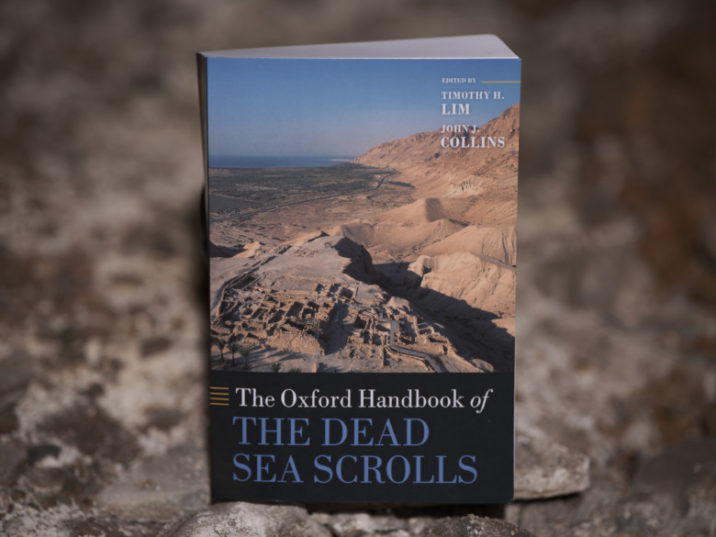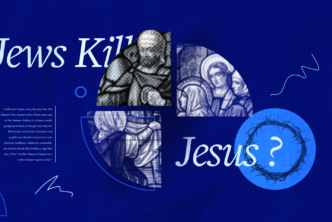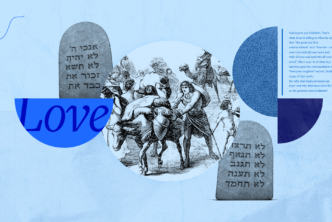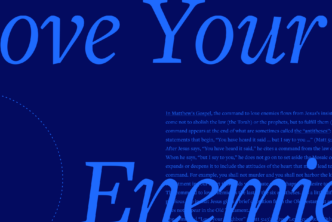The Oxford University Press Handbooks are renowned as go-to volumes for students and scholars alike when embarking on research in new topics, or for seasoned scholars who desire efficiency when seeking to grasp the essential bibliographies for any number of issues within biblical and religious studies.
The second interview in our series is with Timothy Lim, Professor of Hebrew Bible & Second Temple Judaism at the University of Edinburgh, and editor of The Oxford Handbook of the Dead Sea Scrolls.

What is special about the OUP Handbooks, and why should students and scholars use them in their research?
The OUP Handbooks series intends two aims that are sometimes regarded as separate publication goals. First, it aims to provide an authoritative and up-to-date survey of a particular subject area, such as one finds in an encyclopaedia. Second, it offers critical reviews of the progress and direction of scholarly debates, providing a foundation for future research. This latter goal is often explicitly stated or implied in publications that are conceived as ‘prospects of research’ or ‘new directions’. The Handbook series is aimed at postgraduate students and scholars, but is also useful for advanced undergraduates and the interested lay reader.

Tell us a bit about what you wished to accomplish as editor of The Oxford Handbook of the Dead Sea Scrolls and how you think that goal was achieved.
When OUP approached me to edit this volume, I sought to provide a volume that would cover most of the research areas in the bourgeoning field of Qumran studies. I also wanted an international group of leading contributors.
I invited my good friend and colleague, John J. Collins (Yale), to co-edit the volume, and together we commissioned articles by British, American, Israeli and European scholars.
I believed that we achieved our goal and reviews of the volume as well as anecdotal evidence from colleagues confirm this impression.

For readers unfamiliar with your work, can you tell us about your background in the Dead Sea Scrolls (DSS) and how that prepared you for the role of editor of the Handbook?
I first came across the Dead Sea Scrolls as an undergraduate in the Classical, Near Eastern and Religious Studies Department at the University of British Columbia. I took my postgraduate degrees at the Oriental Institute of the University of Oxford, reading for a MPhil in Judaism in the Graeco-Roman Period, and writing my DPhil dissertation (supervised by Geza Vermes) on the Bible in the Pesharim (sectarian biblical interpretations) and the Pauline letters. I became Kennicott Hebrew Fellow at the Oriental Institute and Oxford Centre for Hebrew and Jewish Studies, and before I completed this post-doctoral fellowship, I was headhunted by the University of Edinburgh for a newly created lectureship in Dead Sea Scrolls and Christian Origins. Since that time, I have branched out into other areas of Biblical and Jewish Studies, especially in the related area of canon research, but the core of my research has always been and continues to be on the Dead Sea Scrolls.
I have written several books on the Dead Sea Scrolls, including The Earliest Commentary on the Prophecy of Habakkuk (OUP 2020), The Formation of the Jewish Canon (YUP 2013), Pesharim (Bloomsbury 2002), and Holy Scripture in the Qumran Commentaries and Pauline Letters (Clarendon Press 1997). I also wrote a popular book, The Dead Sea Scrolls. A Very Short Introduction (OUP 2005; 2nd edition 2017), which has been translated into several languages and made into an audiobook by Audible.com.
I have had different kinds of editorial roles. I was principal editor of the The Dead Sea Scrolls Electronic Reference Library, Volume 1: The Dead Sea Scrolls on CD ROM (OUP & Brill 1997), and editor of 4Q303-305 and 4Q307-308 of the Discoveries in the Judaean Desert series (Clarendon Press). Not counting the Oxford Handbook, I have also edited five other volumes, two of which are directly on the Dead Sea Scrolls: On Scrolls, Artefacts, and Intellectual Property (Bloomsbury, 2001) and The Dead Sea Scrolls in their Historical Context (T & T Clark 2000). The textual- and study-type of editing is combined in my current role as the general editor of a new commentary series called, The Oxford Commentary on the Dead Sea Scrolls (OUP).

What distinguishes the collection of essays in the Handbook from other collections of essays on the DSS?
The Oxford Handbook of the Dead Sea Scrolls is not the proceedings of a conference nor a Festschrift of essays with various topics around a general theme. It is a collection of specially commissioned contributions by leading and international experts to evaluate critically important trajectories of research and provide directions of further research. It is ideal for the researcher at all levels, but also valuable for senior undergraduate students who may be looking to postgraduate research.

Can you briefly walk us through the eight sections into which the Handbook is divided?
We divided the volume into eight sections, covering familiar topics and more recent approaches. The first section is on the archaeology of Khirbet Qumran and the Judaean Wilderness. Debates about the relationship between the scrolls, caves, archaeological site of Khirbet Qumran, and the adjoining cemetery are the focus of this section. This was followed by a second section that sets the scrolls within the historical context of early Judaism broadly defined.
The third section, then, addressed the scrolls relationship to Jewish sectarianism, an important feature of Jewish religion at the end of the Second Temple period. This section covered not only the classical notices about the Essenes, but also debates about the calendar, the composition of the communities reflected in the scrolls, and the importance of the Book of Enoch.
The fourth section sought to assess one of the most important contributions of the scrolls: the textual fluidity and formation of the Hebrew Bible or Old Testament. What was the sectarian concept of authoritative scriptures and how were they similar to and different from the ‘holy scriptures’ of ancient Judaism and Christianity? The fifth section constitutes six chapters on various religious themes found in the scrolls (e.g. purity, apocalypticism, mysticism, wisdom).
The sixth section covers the intersection between the scrolls and early Christianity. The three chapters cover the historical context, shared exegetical traditions, and monotheism. In the early days of Qumran research, this was by a long way the topic that garnered the most attention. It is time to revisit this question in the light of advances in Qumran research and our better understanding of the sectarian matrix of the Judaism of the Essenes, Pharisees, Sadducees, Therapeutae, Jesus, Paul and other New Testament writers.
The seventh section surveys and reviews the continuity and discontinuity between the laws and liturgy of the scrolls and the halakhic disputations in Rabbinic Judaism and the documents from the Cairo Genizah.
Finally, three chapters conclude the volume in assessing what has been done and the prospects of research in the overlap between the study of the scrolls and rhetoric, post-modernism, and copyright law.

What are some of the advantages you see for readers to have the Handbook available digitally in Logos?
This edition will open up the research of the Handbook for easy access. Most of the chapters are around 10k words long, and while it is salutary to read each chapter from beginning to end, it is also useful to have a facility to search the contents where memory is fuzzy and the scan of the eye fails to identify a particular point that one has read.
The Logos edition adds value in another respect. Searches can reveal connections between chapters in a way that a paper publication could not readily do. Links to other resources, such as the Qumran modules and biblical texts, would further enhance the interface between reader and resource. It is a welcome development in the dissemination of the Handbook.

Finally, which project(s) of yours should we look out for in the coming years that also deal with the DSS?
As I mentioned, I am the general editor of The Oxford Commentary on the Dead Sea Scrolls. This series is intended for the scholarly study of the most important non-biblical Dead Sea Scrolls, providing scholarship of the highest level that is accessible to the non-specialists and based on the best digitized images and readings. The first volume of the series appeared last year, my commentary entitled The Earliest Commentary on the Prophecy of Habakkuk (OUP 2020). This is the first commentary on Pesher Habakkuk for forty years and is also a new edition of the text. A second volume on the Damascus Document is now with the Press and will appear soon. Here’s the link: https://www.ocdss.div.ed.ac.uk


The Oxford Handbook of the Dead Sea Scrolls is now available for pre-order on Logos, just one of a fantastic lineup of individual volumes from the Oxford University Press Handbooks series.
In addition, Logos is offering two exclusive collections of volumes from the OUP Handbook series, at special pre-order pricing:
The Oxford Handbooks Biblical Studies Collection (8 vols.)

The Oxford Handbooks Religion Collection (26 vols.)
Take advantage of these special offers now, before the pre-order window closes.






